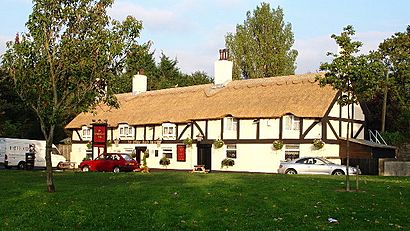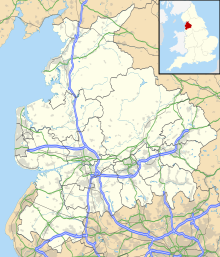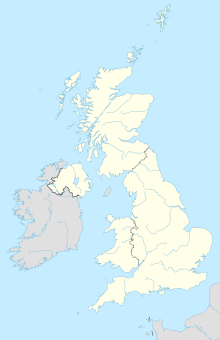Battle of Bamber Bridge facts for kids
Quick facts for kids Battle of Bamber Bridge |
|||
|---|---|---|---|
| Part of Second World War | |||

Ye Olde Hob Inn, where the violence started
|
|||
| Date | 24–25 June 1943 | ||
| Location |
Bamber Bridge, Lancashire, England, United Kingdom
53°43′18″N 2°39′44″W / 53.7217°N 2.6621°W |
||
| Caused by | Racial tensions | ||
| Parties to the civil conflict | |||
|
|||
| Casualties | |||
| Death(s) | 1 | ||
| Injuries | 7 | ||
| Charged | 32, charged with mutiny | ||
The Battle of Bamber Bridge is the name given to a clash that happened between American soldiers in the village of Bamber Bridge, Lancashire, in Northern England. This event took place during the Second World War. Feelings were already tense because US commanders had tried to separate people in local pubs based on their race. Things got worse after similar problems happened in Detroit, USA, in 1943.
The conflict began when white American Military Police (MPs) tried to arrest several African American soldiers. These soldiers were from the 1511th Quartermaster Truck Regiment, which was a unit where black and white soldiers were kept separate. The MPs said the soldiers were not wearing the correct uniform at the Ye Olde Hob Inn public house in Bamber Bridge.
Later, during a street argument, a white MP shot a black soldier named Private William Crossland, who sadly lost his life. More military police arrived with machine guns and grenades. In response, the black soldiers got rifles from their base armoury to protect themselves. Both sides exchanged fire through the night. Later, 32 African American soldiers were found guilty of not following orders. However, it was also recognized that poor leadership and unfair attitudes from the MPs were part of the problem.
Contents
What Led to the Battle of Bamber Bridge?
During the Second World War, Bamber Bridge was home to American soldiers from the 1511th Quartermaster Truck regiment. This unit was part of the Eighth Air Force. Their base, called Air Force Station 569, was on Mounsey Road. The 1511th Quartermaster Truck unit was in charge of delivering supplies to other Eighth Air Force bases in Lancashire. The 234th US Military Police Company was also in the town.
At that time, the US Armed Forces still separated soldiers by race. Almost all the soldiers in the 1511th Quartermaster Truck unit were black. However, nearly all their officers and the military police were white. Sometimes, less experienced leaders were put in charge of these units, which led to poor leadership.
Feelings were already tense because of similar racial clashes in Detroit, USA, earlier that week. Those events had resulted in 34 deaths.
According to a writer named Anthony Burgess, the people of Bamber Bridge supported the black troops. When US commanders tried to make a rule to keep people of different races separate in the town's pubs, all three pubs reportedly put up "Black Troops Only" signs.
Trials and Outcomes
One report said that one person died and seven people were hurt in the conflict. Even though 32 black soldiers were found guilty of not following orders, poor leadership and unfair attitudes among the MPs were blamed for causing the events. None of the white MPs were put on trial, not even the one who shot the black soldier.
Two trials were held. In August, four of the black soldiers involved in the first fight were sentenced to hard labour. Their sentences ranged from two and a half to three years, and they were also removed from the military. One of these decisions was later changed. The second trial involved 35 soldiers. It ended on September 18 with seven soldiers found not guilty and 28 found guilty. The sentences for those found guilty ranged from three months to 15 years. Seven soldiers received sentences of 12 years or more. However, after reviews, one man was released, and all other sentences were reduced. Fifteen of the men returned to duty in June 1944, and six other sentences were further reduced. The soldier with the longest sentence returned to duty after serving 13 months.
General Ira C. Eaker, who was in charge of the Eighth Air Force, mostly blamed the white officers and MPs. He said it was because of their poor leadership and their use of unfair language. To stop similar events from happening, he combined the trucking units into one special group. He removed inexperienced or unfair officers from this group. He also made sure that black and white military police worked together on patrols. After these changes, the mood among black troops in England got better, and fewer soldiers were put on trial. While there were a few more racial incidents between black and white American troops in Britain during the war, none were as big as the one in Bamber Bridge.
News about the conflict was kept quiet at the time. Newspapers only said that violence had happened in a town somewhere in North West England. The author Anthony Burgess, who lived near Bamber Bridge after the war, wrote briefly about the event in The New York Times in 1973 and in his autobiography, Little Wilson and Big God.
People became more interested in the event in the late 1980s. This happened after a worker found bullet holes from the conflict in the walls of a bank in Bamber Bridge.
What Happened After the Battle?
The Battle of Bamber Bridge was one of the few times during World War II when racial tensions and clashes happened between American soldiers in another country. Similar events also took place in Australia, known as the “Battle of Brisbane”, and in New Zealand, called the “Battle of Manners Street”. These events are important because they show the unfair treatment and separation that existed within the U.S. military back then.
This incident happened in a small town in England, not on a battlefield. This makes it different from typical wartime conflicts. The clash between African American soldiers and white military police in Bamber Bridge was a direct result of the military's rules that separated people by race.
The Battle of Bamber Bridge had effects beyond the immediate event. It led to important talks about treating everyone fairly and bringing different races together within the U.S. military. This eventually led to changes in rules and practices. The event has been described as an early sign of the fights for equal rights that would happen in America later, during the Civil Rights era.
Remembering the Event
In June 2013, to mark 70 years since the incident, the University of Central Lancashire held a special meeting. It included showing a 2009 film called Choc'late Soldiers from the USA, made by Gregory Cooke. There was also a play called Lie Back and Think of America, written by Natalie Penn, which had been performed at the Edinburgh Fringe Festival.
In June 2022, a memorial garden was created across from the pub where the Battle of Bamber Bridge started. This garden helps people remember the event. The incident also inspired the story for the film The Railway Children Return.
See also
- Freeman Field mutiny
- African-American mutinies in the United States Armed Forces



